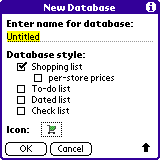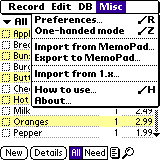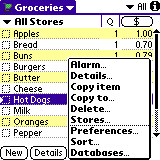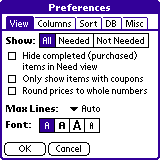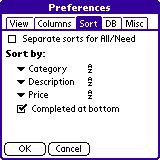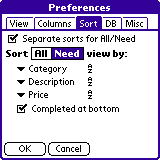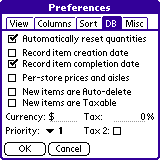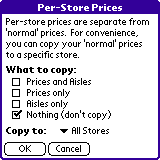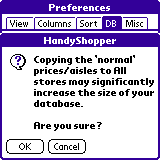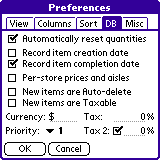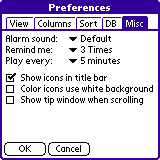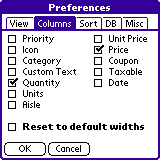
Figure 2.5
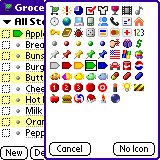
Figure 2.5.2 |
|---|
The second tab in the Preferences screen is the Columns tab. The Columns Preferences (Figure 2.5) allow you to select the fields you would like HandyShopper to display for each item in your list. While it is possible to have several columns shown in the list view by narrowing the width when possible, you can't make them ALL show up. Columns can be adjusted in width by dragging the "handle" for the column in the list view (see section on the List View). With a little tweaking and decision making, an ideal column selection can be made for any list purpose.
- Priority:
The Priority column appears at the left side of the list view,
the first column of data after the actual checkbox column (which
always appears at the left-most side of the screen). Priority
choices are made from a short pop-up list that includes the
numbers from 1 to 5. No other data can be entered into the
Priority field.
- Icon:
Each item in your list can have an icon associated with it. When this column is turned on, a column of icons will appear immediately before the item description. Simply tap the "handle" icon (a small button) to access the icon chooser (Figure 2.5.2) to pick a new icon for the item. Items may still have icons assigned to them via the item details screen, and if the icon column is turned off, an item's icon will appear at the far right of the description field, after the note and alarm icons if present. No matter the location of the icon, a quick tap on the icon will bring up the icon chooser again. A tap-and-hold on the icon will switch directly to the details screen for that item. This column cannot be adjusted in width.
- Category:
This allows you to select the category for each item in the list
view from the user defined set of categories via a pop-up list.
As with most Palm OS applications, categories are limited to 15
user categories, not including the Unfiled category. Category
names can be up to 15 characters long, including spaces and
other non-alphanumeric characters. The category column can be
widened to more than half the screen, and narrowed down to five
pixels.
- Custom Text: A somewhat unique field, this one can store any data
you would like as direct input (no pop-ups). This field can
store a whopping 255 characters! While the data can't be
pre-configured and chosen quickly for each item, it's ability to
store so much information, the same amount as an item
description, AND to be another field for the list to be sorted
by, makes it very useful for non-shopping list purposes. To
enter text into this field, it must be shown in list view, as
this field is the only one that is otherwise completely
inaccessible in HandyShopper. When it's shown, simply tap the field to
enter data into it as you would with the description field. This
column can be widened to more than half the screen, and narrowed
down to five pixels.
- Quantity:
This field will accept any number up to 999999.999. Note that
you can enter up to 10 characters, but if the actual number is
above the limit, an error message will appear. Decimal places
are rounded to the third decimal place. For example, .0059 would
be converted permanently to .006. This is NOT a change for
display purposes like the "Round prices to whole numbers"
feature in the View Preferences. This rounding is real and
permanent. Then again, what in the world would you need more
flexibility in the Quantity field for, anyway? ;-) This column
can be widened to more than half the screen, and narrowed down
to five pixels. Since it can only hold a number as large as
999999.999, it doesn't do much good expanding the column width
past that, but it's nice to be able to make it big enough for
any number that fits that field.
- Units: This is a unique field in that you can choose from a pop-up list of user configurable selections (from a global list that all HandyShopper lists can choose from, limited to 50 user entered choices, limited to 15 characters each) and
you can enter any text you want up to 15 characters. As such, if
you have a field of data with 15 or less characters that you'd
like to be able to sort by, you can use this field. If you need
more than 50 different choices, simply enter them in the field
directly by choosing "Other..." from the pop-up list of choices
in the list view of your database. The Units field also has a new, higher purpose... It is now involved in the calculation of Unit Price! See the Unit Price description for more information on this feature. The Units column can be widened to
more than half the screen, and narrowed down to five pixels.
- Aisle:
Turning on the aisle column for your list can be very helpful
when editing your shopping list to include aisles, as well as
when shopping for your items to more efficiently move through
the store. This column can be widened to more than half the
screen, and narrowed down to five pixels, though making it wider
than three characters has little value. It's worth noting that
the Aisle column has it's own quirks. It can store any number
from 1 to 200, AND from A to Z, which are all selected by a
pop-up list. When you tap the Aisle data for an item, a very
long pop-up list appears. You can move through the list to find
what you want by scrolling with the on-screen arrows or with the
hardware scroll buttons on your device. If your desire is for a
high number, or a letter, both of which are very far down the
list, you can make short work of selecting the choice you want
by using graffiti to enter the first character. This will either
skip all the way down the list to the first instance of the
character you enter, or choose it automatically. For example,
since the A to Z aisles are only one character, if you write the
graffiti character for A, then A will automatically be chosen
for you. If you enter the number 1, then a number 5, the list
will skip down to the number 15. As soon as you enter another
number, such as a 3, the number 153 will automatically be
selected as the aisle for the item you are editing. If you only
need a one or two digit number, writing the number, then tapping
it in the list, or writing the return stroke in graffiti, will
select it for you. Simply playing with this feature will help
you understand how it works very quickly.
- Unit Price: This field displays the calculated price for one unit of an item. For Unit Price to calculate properly, the item must have a price, and a unit with a number in it such as "oz. 6" or "6 ounces." HandyShopper will then divide the price by the number of units in the item, to show you the Unit Price for that item. This makes price comparisons easier while still allowing for an accurate total. Quantity does not effect this calculation, and the Unit Price has no bearing on the total cost calculations, so you can still choose "2" for Quantity, and "$1.99" for Price, while having a Unit of "6 ounces" to calculate a Unit Price of $.332. :) Yes, this can get somewhat confusing. Just remember that HandyShopper needs a number in the Units field to calculate Unit Price. :) With the Unit Price column displayed, tapping on it will bring up the Best Buy calculator with the item's details pre-filled in the "Item B" area. Entering a price and number of units for another item allows for quick and easy comparison shopping. This field can also be widened and narrowed quite a bit.
- Price:
Similar to the quantity column, you can enter any number up to
999999.99. Rounding for price now occurs at two decimal places,
though. Any number too large to show in the list will be
replaced with ##. To avoid this, widen the column, which can be
widened to more than half the screen, and narrowed down to five
pixels.
- Coupon:
This column is another checkbox. It's called coupon because you
can use the "Only show items with coupons" feature in the View
Preferences to filter out all items that are not marked as
coupons (or having a coupon to go with it). That is essentially
the only purpose of this column, but some users have been known
to use it as a sort of temporary checkbox, or reminder checkbox.
To effectively use the coupon checkbox for coupons, you need to
check the box for all items in your list that you have coupons
for, then create duplicates of all those items (also with the
coupon box checked, and maybe a slightly different item name,
such as "Macaroni (coupon)") but with the value of the coupon
entered in the price field as a negative number. With
appropriately assigned quantities, the total calculated by HandyShopper
will be accurate including the coupon discounts. Using the "Only
show items with coupons" option in the View Preferences can make
it easier to shop with coupons by hiding all the items for which
you have no coupons. This column cannot be widened or narrowed
because it is just a checkbox.
- Taxable:
Provides a checkbox in the column to designate if the item is
taxable or not. In many places, some items are taxed, and some
are not. To make sure your totals are accurate, make sure to
mark only those items that are taxed. If the Tax 2 option is
enabled in the Database Preferences (explained below) then an
additional taxable checkbox will appear. The tax columns will
then be labeled T1 and T2. This column cannot be widened or
narrowed because it is just a checkbox.
- Date: Shows
the assigned date for the item. This column can only be
displayed two ways, one showing mm/dd, and the other showing
mm/dd/yy. There can be only one date stored per item, which can
be assigned automatically upon item creation or deletion, or
assigned by the user.
- Reset to default widths: This is a temporary option that allows you
to reset all the column widths to their default values. If you
have modified any of the column widths, they are stored in the
list database file so that they will be remembered even after
beaming or editing the list. If you want to restore the default
column widths for all columns, simply check this box, and tap
the OK button to save changed preferences. All the column widths
will be their default widths, and the "Reset to default widths"
checkbox will be empty when you return to the Columns
Preferences screen.
- OK and Cancel buttons: Tapping the OK button will save the changes you have made in any and all of the preferences screens and return to the list view. Tapping the Cancel button will not save any changes and your preferences will revert to the state that they were in upon entering the preferences screen.
|
